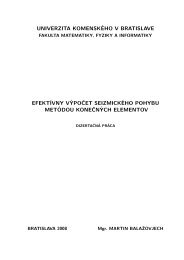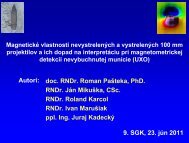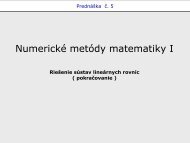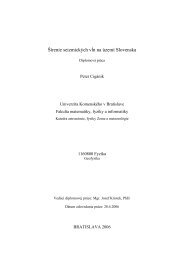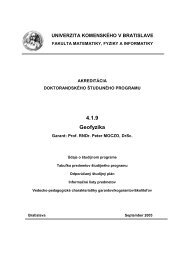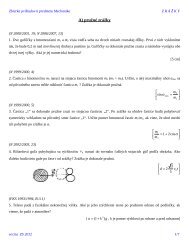Ternary Phase Diagrams - fyzikazeme.sk
Ternary Phase Diagrams - fyzikazeme.sk
Ternary Phase Diagrams - fyzikazeme.sk
You also want an ePaper? Increase the reach of your titles
YUMPU automatically turns print PDFs into web optimized ePapers that Google loves.
GLY 421: Igneous & Metamorphic PetrologyEl-Shazly, A. K., 20087consist of Opx and Plag (in our example representing crystallization along the cotecticbetween J and E; Fig. 14).2- Corona textures in many gabbros where Ol crystals are rimmed by Opx (andsubsequently Cpx). This can be explained by incomplete fractional crystallization of amelt of composition similar to D (Fig. 14).3- The occurrence of layers of Qz-gabbros (or Qz-gabbronorites) with granophyrictextures within layered intrusions of an Ol-tholeiitic magma can also be explained by thisdiagram. Fractionation of Ol from the tholeiitic magma (to form early cumulates) willpush the melt composition across the plane of SiO 2 oversaturation, and this liquid willend up crystallizing Plag + Opx + Qz at the ternary eutectic.4- In a layered complex, the layers dunite, bronzitite, norite and granophyre closelyrepresent the compositional evolution of a tholeiitic melt undergoing fractionalcrystallization. (Can you work this out from Fig. 14?).5- The diagram can be used to explain why scientists believe that norite does not formfrom a noritic magma, but by fractional crystallization of a tholeiitic melt. This is simplybecause the first melt to form by partial melting in this system will always be "granitic"(rather than noritic) in composition (i.e. a liquid which is fairly rich in SiO 2 ) since it hasto be of eutectic composition.4- <strong>Ternary</strong> systems with solid solutionA- The system Ab - An - DiThe joins Ab - Di and An - Di are both binary eutectics, whereas the subsystem Ab - Anis characterized by complete solid solution. The ternary phase diagram Di - An - Ab willtherefore appear rather simple, with one subtraction curve (cotectic curve) joining the twobinary eutectics E 1 and E 2 (Fig. 15). Two phases: Di and a plagioclase (solid solution)will precipitate continuously along this cotectic. The direction of migration of the liquidcomposition along the cotectic is determined experimentally (the alkemade theorem doesnot help in this case). Nevertheless, if we are familiar with the binary solid solutionsystem, we can probably predict this direction (as it is usually the same as that for thebinary).Another problem with this system is our inability to figure out the composition ofplagioclase feldspar crystallizing in equilibrium along the cotectic with diopside from theprinciples we learned earlier. In fact, the only proper way for determining the compositionof the solid plagioclase is through experiment. Nevertheless, familiarity with the binaryfor plagioclases (Fig. 15, lower diagram) can be helpful in this regard. This is simplybecause the composition of the liquid along the eutectic can be easily determined fromthe ternary. If we then project this composition down onto the binary diagram (assumingthat the presence of Di has no effect on the shapes of the liquidus and solidus curves ofcoexisting plagioclase, an assumption which is not strictly correct), we can immediatelyfigure out the



